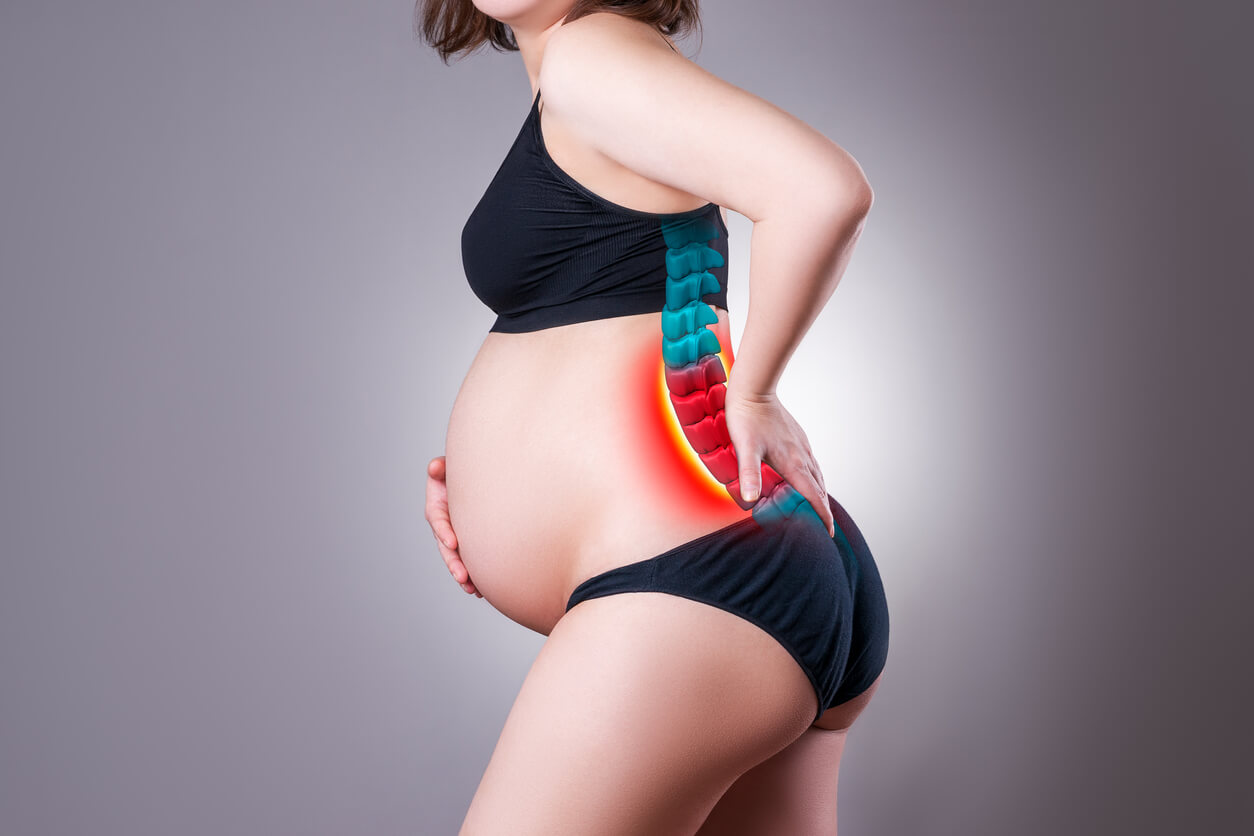Vaginal Pain During Pregnancy: What's the Cause?


Written and verified by the nurse Leidy Mora Molina
The changes that a mother’s body undergoes during gestation are enormous, and some of them can be quite uncomfortable. One of the most common is vaginal pain, which usually intensifies in the third trimester.
Despite the discomfort, pelvic pain at this stage is completely normal, as it responds to the anatomical changes necessary to make room for the baby and give birth.
Here, we’ll tell you everything you should know about this symptom and when you should consider consulting a doctor.
Why does vaginal pain occur in pregnancy?
Vaginal pain is a fairly typical sensation among pregnant women and can occur occasionally (as pricks) or permanently throughout the process.
Although it doesn’t represent a gestational complication, for many mothers, it can be quite disturbing. Especially when combined with other discomforts, such as sciatic pain or constipation.
As we’ve already mentioned, the reason for the pain is the adaptive changes that the maternal body undergoes in order to gestate the baby. Among some of these changes, we can highlight the weakening or softening of the ligaments and muscles of the pelvic area.
Here are the factors involved in the genesis of this symptom.
Hormonal action

Relaxin is a hormone that’s secreted during pregnancy, especially in early and late pregnancy. One of its main tasks is to relax the ligaments, muscles, and other soft tissues of the pelvis to facilitate labor. As a consequence, the abdominal and pelvic organs move downward under the action of gravity and put pressure on the vagina.
It’s considered a logical explanation for genital pain during the first trimester, when the baby isn’t yet large enough to exert much pressure. However, it remains a controversial issue. One study failed to find an association between relaxin levels and the incidence of pelvic girdle pain in pregnant women.
Find out more: 9 Ways Your Body Changes After Pregnancy
Increased vascularization in the pelvis
From the beginning of pregnancy, the maternal body increases the blood volume to increase the irrigation of the uterus. This allows the embryo to nourish, grow, and develop.
But increased vascularization also occurs in all pelvic organs and tissues, including the vaginal canal and vulva. For this reason, it’s possible to see some edema and color change in the external genitalia of women from the first trimester of pregnancy. The same occurs with the regional veins, which may result in the development of varicose veins and vaginal pain.
Uterine pressure
By the third trimester, all vaginal discomfort tends to worsen due to the weight of the uterus on this organ. This pressure causes a widening of all pelvic tissues, which results in cramping, pinching, and pain.
In many cases, this is due to pressure on the genitocrural nerves, which are only sensitive and innervate the genital region and the uppermost part of the lower limb.
Also, the weakening of the pelvic floor is intensified by the weight and size of the uterus, which decreases the ability to support the abdominal structures that exert pressure on the vagina.
Changes in the position of the baby
As labor approaches, the baby settles into the cephalic position. That is, with the head down in order to exit through the birth canal. As we mentioned with the uterus, this structure exerts pressure on the vagina and awakens the painful sensation, which also radiates towards the hips.
Find out more: Does the Fetus’s Position Indicate What Delivery Will Be Like?
Other causes of vaginal pain not related to pregnancy
In some cases, it’s possible to explain the pain with situations that aren’t exclusively related to pregnancy:
- Cervical incompetence. This condition, also called cervical insufficiency, is related to a cervix that’s too soft or weak. It’s unable to withstand the strong pressures of a developing fetus, which can eventually lead to miscarriage or premature delivery. Pressure and pain in the pelvis and genitals are one of the few symptoms that may alert you.
- Constipation. If you go several days without a bowel movement, abdominal pain may spread to the pelvic and genital region. The pregnancy-related factors mentioned above may contribute to the onset of pain or discomfort.
- Urinary tract infections. This symptom is especially related to lower infections, such as cystitis. The pain may be exacerbated by urination and accompanied by burning.
- Pelvic organ prolapse. In this condition, the reproductive organs protrude through the vagina. While it’s of concern at any time, it’s more significant during pregnancy. According to publications, due to the rarity of these cases, there’s still a great deal of controversy surrounding their treatment.
What can I do if I feel vaginal pain during pregnancy?
There’s no curative treatment for pregnancy vaginal pain, as it responds to the physiological changes of this state. However, you can resort to certain painkillers, as long as they’re prescribed by a specialist.
At the same time, staying hydrated and practicing low-impact exercises (walking, yoga, or pilates) can help reduce the pain in this area.
Also, another way to avoid or reduce the intensity of this symptom is through Kegel exercises. These strengthen the pelvic floor muscles and thus prevent the prolapse of the abdominal and pelvic organs over the vagina.
It’s a good idea to practice these exercises daily, especially throughout pregnancy. This routine reduces pain in the pelvic area in the last trimester, facilitates childbirth, and reduces the risk of vaginal tears during childbirth. In addition, it accelerates the recovery of the maternal body in the postpartum period.

About vaginal pain during pregnancy
Ideally, when this discomfort appears, you should be evaluated by your doctor, so that they can assess the origin of the discomfort. Although we’ve reiterated that it’s usually one of the adaptive changes of pregnancy, it can also occur for other reasons.
Similarly, if this pain appears in the last month of pregnancy and is accompanied by rhythmic uterine contractions, it could be an indication that the arrival of the baby is very close.
The changes that a mother’s body undergoes during gestation are enormous, and some of them can be quite uncomfortable. One of the most common is vaginal pain, which usually intensifies in the third trimester.
Despite the discomfort, pelvic pain at this stage is completely normal, as it responds to the anatomical changes necessary to make room for the baby and give birth.
Here, we’ll tell you everything you should know about this symptom and when you should consider consulting a doctor.
Why does vaginal pain occur in pregnancy?
Vaginal pain is a fairly typical sensation among pregnant women and can occur occasionally (as pricks) or permanently throughout the process.
Although it doesn’t represent a gestational complication, for many mothers, it can be quite disturbing. Especially when combined with other discomforts, such as sciatic pain or constipation.
As we’ve already mentioned, the reason for the pain is the adaptive changes that the maternal body undergoes in order to gestate the baby. Among some of these changes, we can highlight the weakening or softening of the ligaments and muscles of the pelvic area.
Here are the factors involved in the genesis of this symptom.
Hormonal action

Relaxin is a hormone that’s secreted during pregnancy, especially in early and late pregnancy. One of its main tasks is to relax the ligaments, muscles, and other soft tissues of the pelvis to facilitate labor. As a consequence, the abdominal and pelvic organs move downward under the action of gravity and put pressure on the vagina.
It’s considered a logical explanation for genital pain during the first trimester, when the baby isn’t yet large enough to exert much pressure. However, it remains a controversial issue. One study failed to find an association between relaxin levels and the incidence of pelvic girdle pain in pregnant women.
Find out more: 9 Ways Your Body Changes After Pregnancy
Increased vascularization in the pelvis
From the beginning of pregnancy, the maternal body increases the blood volume to increase the irrigation of the uterus. This allows the embryo to nourish, grow, and develop.
But increased vascularization also occurs in all pelvic organs and tissues, including the vaginal canal and vulva. For this reason, it’s possible to see some edema and color change in the external genitalia of women from the first trimester of pregnancy. The same occurs with the regional veins, which may result in the development of varicose veins and vaginal pain.
Uterine pressure
By the third trimester, all vaginal discomfort tends to worsen due to the weight of the uterus on this organ. This pressure causes a widening of all pelvic tissues, which results in cramping, pinching, and pain.
In many cases, this is due to pressure on the genitocrural nerves, which are only sensitive and innervate the genital region and the uppermost part of the lower limb.
Also, the weakening of the pelvic floor is intensified by the weight and size of the uterus, which decreases the ability to support the abdominal structures that exert pressure on the vagina.
Changes in the position of the baby
As labor approaches, the baby settles into the cephalic position. That is, with the head down in order to exit through the birth canal. As we mentioned with the uterus, this structure exerts pressure on the vagina and awakens the painful sensation, which also radiates towards the hips.
Find out more: Does the Fetus’s Position Indicate What Delivery Will Be Like?
Other causes of vaginal pain not related to pregnancy
In some cases, it’s possible to explain the pain with situations that aren’t exclusively related to pregnancy:
- Cervical incompetence. This condition, also called cervical insufficiency, is related to a cervix that’s too soft or weak. It’s unable to withstand the strong pressures of a developing fetus, which can eventually lead to miscarriage or premature delivery. Pressure and pain in the pelvis and genitals are one of the few symptoms that may alert you.
- Constipation. If you go several days without a bowel movement, abdominal pain may spread to the pelvic and genital region. The pregnancy-related factors mentioned above may contribute to the onset of pain or discomfort.
- Urinary tract infections. This symptom is especially related to lower infections, such as cystitis. The pain may be exacerbated by urination and accompanied by burning.
- Pelvic organ prolapse. In this condition, the reproductive organs protrude through the vagina. While it’s of concern at any time, it’s more significant during pregnancy. According to publications, due to the rarity of these cases, there’s still a great deal of controversy surrounding their treatment.
What can I do if I feel vaginal pain during pregnancy?
There’s no curative treatment for pregnancy vaginal pain, as it responds to the physiological changes of this state. However, you can resort to certain painkillers, as long as they’re prescribed by a specialist.
At the same time, staying hydrated and practicing low-impact exercises (walking, yoga, or pilates) can help reduce the pain in this area.
Also, another way to avoid or reduce the intensity of this symptom is through Kegel exercises. These strengthen the pelvic floor muscles and thus prevent the prolapse of the abdominal and pelvic organs over the vagina.
It’s a good idea to practice these exercises daily, especially throughout pregnancy. This routine reduces pain in the pelvic area in the last trimester, facilitates childbirth, and reduces the risk of vaginal tears during childbirth. In addition, it accelerates the recovery of the maternal body in the postpartum period.

About vaginal pain during pregnancy
Ideally, when this discomfort appears, you should be evaluated by your doctor, so that they can assess the origin of the discomfort. Although we’ve reiterated that it’s usually one of the adaptive changes of pregnancy, it can also occur for other reasons.
Similarly, if this pain appears in the last month of pregnancy and is accompanied by rhythmic uterine contractions, it could be an indication that the arrival of the baby is very close.
All cited sources were thoroughly reviewed by our team to ensure their quality, reliability, currency, and validity. The bibliography of this article was considered reliable and of academic or scientific accuracy.
- American Pregnancy Association (2021). Uterus Size During Pregnancy. Recuperado de: https://americanpregnancy.org/healthy-pregnancy/pregnancy-health-wellness/uterus-size-during-pregnancy/.
- Apaza, J. (2015). Flujo sanguíneo uterino en el embarazo. Perú. Revista Peruana de Ginecología y Obstetricia Vol.61 Nº2.
- Lacassie, H. (2014). Dolor y Embarazo. Revista Médica Clínica Las Condes. Vol. 25. Núm. 4. páginas 641-650.
- Mayo Clinic (2021). Prolapso uterino. Recuperado de: https://www.mayoclinic.org/es-es/diseases-conditions/uterine-prolapse/symptoms-causes/syc-20353458.
- Albert H, Godskesen M, Westergaard JG, Chard T, Gunn L. Circulating levels of relaxin are normal in pregnant women with pelvic pain. Eur J Obstet Gynecol Reprod Biol. 1997 Jul;74(1):19-22. doi: 10.1016/s0301-2115(97)00076-6. PMID: 9243195.
- Gutierrez-Barquín I, et al. Gestación y prolapso uterino. Progresos de Obstetricia y Ginecología 2008;51(12):742-744. Disponible en: https://www.elsevier.es/es-revista-progresos-obstetricia-ginecologia-151-articulo-gestacion-prolapso-uterino-S0304501308763167.
This text is provided for informational purposes only and does not replace consultation with a professional. If in doubt, consult your specialist.








